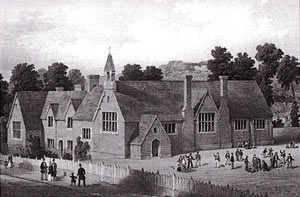
St Sidwell's School
By the middle of the 17th century, Exeter had opened at least three schools in the city from charitable foundations. However, there were no schools outside the city wall until Sir John Bury, a Cathedral clergy funded, in 1665, St Sidwell's Church of England School. The original deeds suggest that the school would be free, or the 500 year lease would be revoked. Over the next years, the school was housed on a narrow site, in the churchyard, on the corner of York Road and Well Street. By 1838, there is evidence that the school was in Cheeke Street.
There is one prominent citizen from the early 19th century who attended the school. Charles Wescomb was born in Paris Street, in 1828, the son of a bricklayer. He made a fortune from investing in mines and was the owner of the Exeter and Plymouth Gazette and the London, Globe newspapers. Within the city he become Sheriff, and was an influential figure in setting up the Royal Albert Memorial Museum. Unfortunately, his reputation came to an ignominious end when, after he died in 1869, it was found that he was in fact bankrupt, and owed money to many people. His misfortune arose, because he had funded the purchase of mining shares and his newspapers with borrowed money. By 1868, the shares had tumbled in value and he had to borrow from friends to keep the newspapers going. His death, from a stroke was supposedly brought about by an angry meeting with a creditor.
A New School House
The present school site was occupied in 1853, when a new school was designed by Edward Ashworth, a former pupil of Charles Fowler, architect of the Lower Market. Built in a Victorian Gothic style, the school had separate boys and girls classrooms, linked by a house for the headmaster, Mr Fewings. The girls' mistress was a Mrs Rowe.
By 1862 there were a thousand pupils in the boys, girls and infant departments. The children paid 2p per week towards the cost of books. Use was made of 'pupil teachers', 15 year olds who were apprenticed to the school for 3 years.
As a result of the 1870 Education Act, Ragged or Free schools were set up in Exeter - one was in West Street and one in St James' Road. They provided a completely free education for those too poor to pay 2 pence per week. In the same year, St Sidwell's opened a new building for infants behind the school. Over the next few years, additional classrooms were added to accommodate even more children.
Into a New Century
In the early 1900's, shorthand, typing and French were taught, and both Dickens and Shakespeare, studied. At this time, the age range was 5 to 14 years old. The First World War saw the school used on several occasions for billeting troops, including the Black Watch.
It wasn't until 1938 that St Sidwell's became more like the modern primary school we know today when it was split into a boys and girls/infants school - more importantly, the pupils transferred to senior school at the age of 11. The blitz of May 1942 saw the infant block destroyed as well as several house in York Road.
St Sidwell's School became a mixed junior and infant school in 1946. Through the 1950's and 60's various additions were made to the old 1853 buildings to cater for a changing population and changing needs. 1974 saw all schools in Exeter reorganised into a first, middle and secondary system - consequently, Sidwells became a combined first and middle school for 520 pupils.
Gene Kemp, the author of many children's books was a teacher at the school in the 1970's - her Cricklepit books are heavily based on St Sidwell's. She often visits the school, and her books are used with the children to encourage their artwork.
Mr Richard Roberts, the oldest former pupil at 95 years with two young scholars at the open day marking the end of the old school building, in June 2006.
And after more than 300 years, of which 153 have been in the present building, St Sidwell's School is to move into new, purpose built premises, on the same site and the old school house demolished - another landmark for a school that has served the people of St Sidwell's so well, for so long.
 The new St Sidwells Church of England Primary School.
The new St Sidwells Church of England Primary School.  The old school in 2006, before demolition.
The old school in 2006, before demolition.  St Sidwells School in the 19th century.
St Sidwells School in the 19th century.
│ Top of Page │